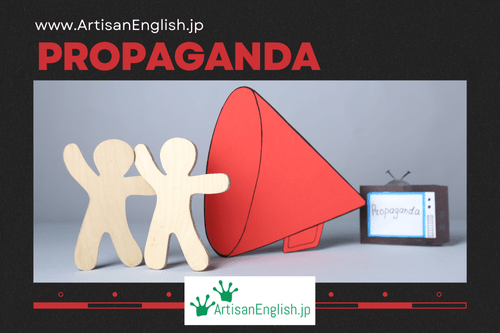
YouTube / iTunes / Spotify / Radio Public / Pocket Casts / Google Podcasts / Breaker / Overcast
Listen to ArtisanEnglish.jp posts & lesson intros here.
WotD: Propaganda
Propaganda is a form of communication that aims to influence people’s beliefs and behaviours.
It often presents information in a biased way, highlighting certain facts while ignoring others.
Historically, propaganda has been linked to significant events, such as Soviet Russia and World War II, where governments used it to control public opinion.
However, we might not realize that we encounter propaganda in our daily lives.
In today’s world, propaganda takes many forms, from advertisements to news stories.
When we watch commercials, they often use emotional appeals to persuade us to buy a product.
This is a type of propaganda that aims to create a positive image of a brand.
Similarly, social media platforms can spread propaganda through misleading posts or sensational headlines that grab attention but may not tell the whole truth.
We’ve all heard about fake news.
Another example of propaganda can be found in political campaigns.
Candidates often present their ideas in a way that makes them look perfect while rebuking their opponents.
This selective presentation of information is a classic form of propaganda designed to sway voters in their favour.
In the internet era, propaganda is not confined to national borders.
It can come from various sources, including foreign entities attempting to influence public opinion in other countries.
Misinformation and conspiracy theories also flourish online, demonstrating how easily propaganda can spread like wildfire and shape our views.
Understanding propaganda is essential in today’s media-rich environment.
A good rule of thumb is to believe half of what you see and nothing of what you hear.
Awareness of propaganda is the first step in protecting ourselves from its influence.
Flesch-Kincaid Readability Test
This post compares in readability to The New York Times.
It is likely to be understood by a reader with at least a 10th-grade education (age 16).
On the Flesch-Kincaid reading-ease test, this post scores 48.
The easier a passage is to read, the higher the score on a scale of 0 – 100.

